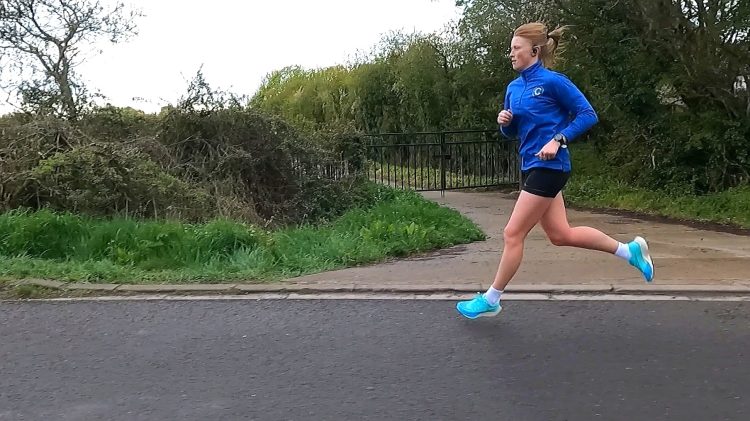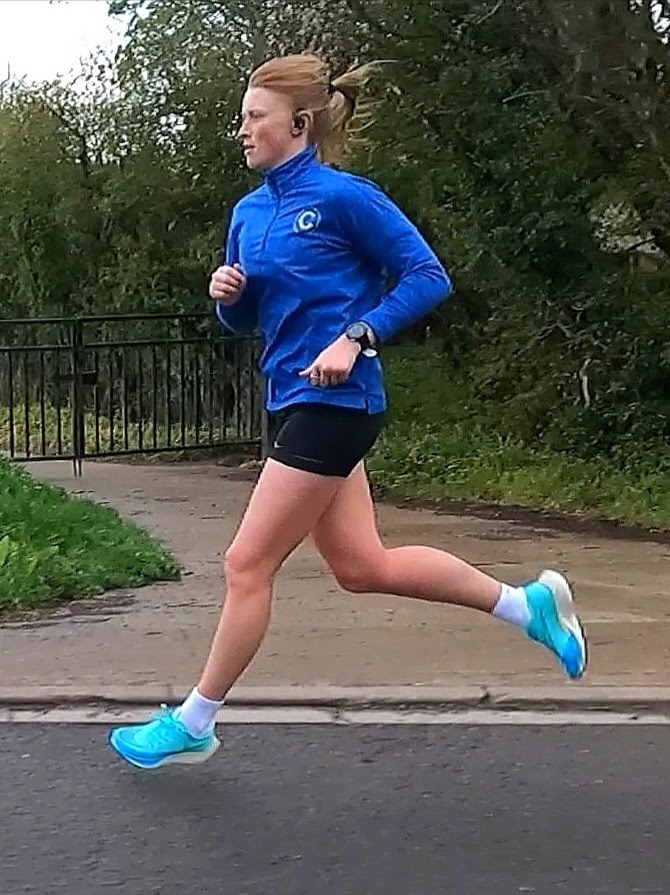In this feature, Stuart Weir allows us to get into the mind of marathoner Nicola Bishop, a PE teacher who loves marathons. She is racing London on October 2, 2022.
The Love of the Marathon
When Nicola Bishop stands on the start line for the 2022 London Marathon, it will be her eighth London Marathon. She has also done Paris, Berlin, Chicago, Barcelona and Boston as well three virtual/solo marathons, whether laps of her parents’ garden or on the roads. Her times are in the region of 3:15, but a sub-three-hour marathon is very much something she has her sights on.
A full-time PE teacher – and a part-time running coach – running has been an important part of her life since she switched from soccer to marathons at university: “I had loved football (soccer) in my teens, but I stopped enjoying it. University was a great opportunity to take up different sports. I took up running and loved it because it could be individual. I could train on my own if I wanted to. Then in my final year, I was successful in the London Marathon ballot, which is unheard of. So university was a reset button. Running has also become a big mental health vehicle which keeps me sane and gives me a focus every day, keeping to a training plan”.

Despite having run marathons in four other countries, London remains the favorite: “Without a doubt, London. Perhaps it’s nostalgic because it was the first I did in 2014, and I have run it consecutively since then. Also, because it’s an hour down the road and accessible to friends and family to come and watch. You could say in terms of crowds, only Boston rivals it. All the elite runners are there; it’s on BBC TV, with a memorable theme tune. And I’m so familiar with the route now”.
Her answer begs the question, what makes one marathon different from another? After all, it is just running 26 miles. Nicola would argue that each one is distinctive in terms of crowd, atmosphere and the whole experience, not to mention differences in the course: “I liked Berlin and Paris because they are circular. Chicago is, too, but it was very much up and back. In Paris, you started on the Champs Elysée. That was brilliant because runners are released in a kind of roller coaster fashion. They would let one side go and then the other, released from pens so that as soon as you started, you were on this massive wide Champs Elysée. It went from a narrow pen to ‘oh my goodness, I am running down the Champs Elysée’. And you saw the Eiffel Tower and the Louvre. Berlin was the same, running under the Brandenburg Gate. Just going on the course alone, Paris or Berlin with Barcelona a close third. Barcelona was along the seafront, which was nice but also bad because it was so hot and also very windy. In terms of atmosphere, I feed off the energy of the crowds a lot. Therefore, I found London easier because of the atmosphere with the crowds 5 or 6 deep”.
While everyone has their PR for the marathon, comparisons are difficult because of the different courses and the elevation profile. Nicola explains: “London is flat, Barcelona is flat whereas Boston is not flat, and that was incredibly difficult. Berlin is a fast, circular course with no sharp bends. Even as an amateur, you can follow the blue line, which means you run just the distance, 42K, not 42.5K. There are rumors that the tarmac in Berlin is a little bit bouncy. But it’s not net uphill or downhill because it’s circular. Just flat with nice curvy bends – although my fastest time was not in Berlin. That said, in every marathon I do, I want to PR, and there are certain marathons that I have entered just to get a PR. It is, so to speak, about controlling the controllable. At the same time, I would do the London Marathon every year, but it’s not a PB course”.
Nicola identifies several reasons London is not likely to produce a fast time: “London is so crowded, meaning that you don’t run the shortest line. People say that you need to train to run 27 miles for London. What I mean is that if I’m running a 7-minute mile and I run an extra half-mile because it is so crowded that you can’t run the shortest line, that is going to be an extra 3:30 more than physiologically what I am able to run. That is why I entered Barcelona because I’d heard it’s flat and not crowded so you can run on the blue line the whole way. I entered Barcelona knowing that physiologically I am capable of shaving three or four minutes off my time without doing anything different. So in London, I ran 3:17 (aiming for 3:15) and did Barcelona four weeks later and ran 3:12. Not because I was fitter but because the course was suited to running faster”.
With 15 marathons behind her, Nicola Bishop is as ambitious as ever. There’s the goal of going sub 3 hours. There is a desire to complete all six majors – New York and Tokyo still to go. Beyond that, as she likes to travel and experience city marathons, Valencia, Geneva, and Melbourne are all on her bucket list.

Even Covid could not stop her as she ran three virtual marathons: “I did one on my 26th birthday because I thought I had to. I did the garden marathon, where I ran laps of 25m – about 1600 laps, which was a great day in lockdown. Then I did the official virtual timed London Marathon in the rain. None of them was my quickest – probably my slowest – but I was doing them for a different reason, whether to celebrate the birthday or raise money for NHS heroes. The garden marathon was really ‘what can I do in lockdown without breaking the rules?’ My mom cycled for 3 ½ hours in the pouring rain for the official virtual one. Friends came out. It all creates a vibe”.
This year will be on the streets of London with the cheering crowds.
Author

Since 2015, Stuart Weir has written for RunBlogRun. He attends about 20 events a year including all most global championships and Diamond Leagues. He enjoys finding the quirky and obscure story.
View all posts






















